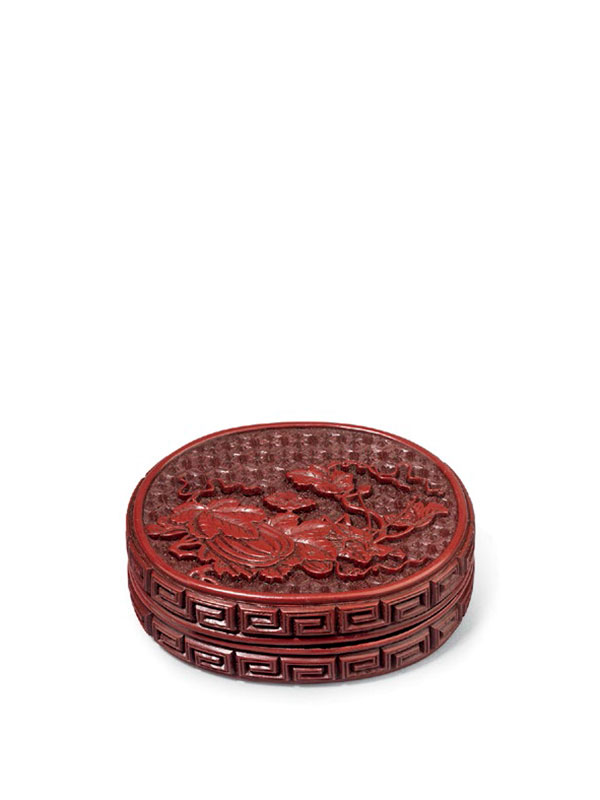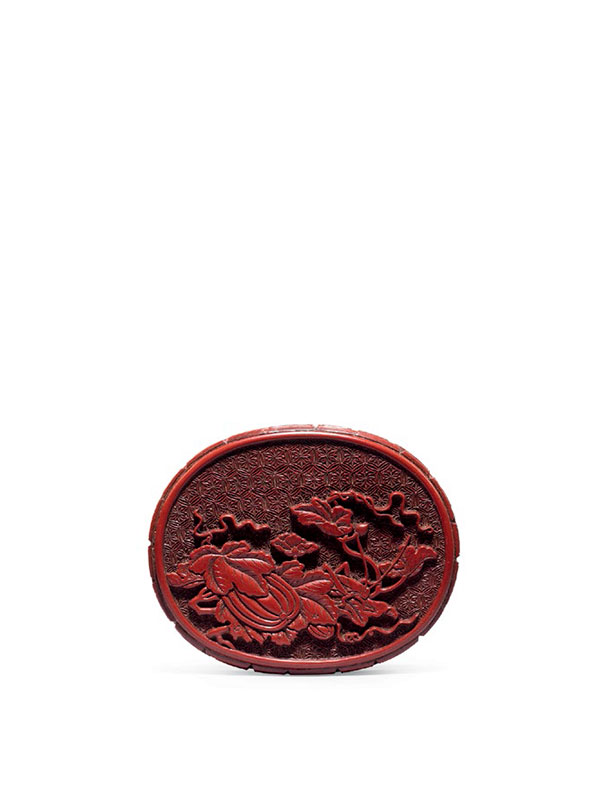Oval lacquer box with cricket and melon
A cinnabar lacquer box of oval form with straight sides. The flat top is carved with a cricket perched on top of a branch of melons with leafy vines and tendrils, against a background of finely carved starburst diaper. A double linked key-fret band runs around the sides of the box and cover. The interior and the base are plain and lacquered in black. The box is contained in an old Japanese wooden box and a brocade pouch.
Both the oval form and decorative motif containing insects and vegetables are unusual in Ming dynasty lacquer wares. Crickets (xi shuai) are associated with spring and summer in Chinese art and were probably most valued as decorative motifs because of the homophonous relationship of their name with ‘happiness’ (xi) and ‘auspiciousness’ (xi).[1] Large and small melons or gourds, together with string-like vines and tendrils are a pun of ‘may there be ceaseless generations of sons and grandsons (guadie mianmian)’ or ‘may you have ten thousand generations of sons and grandsons (zisun wandai)’.[2] The combination of a cricket together with a melon pattern invokes a strong wish for sons and suggests that this elegant box was intended to be given as a present. Oval boxes are extremely rare; an oval box dated to the Southern Song dynasty (1127 – 1279), carved with a branch of plum blossoms, is in the Idemitsu Museum of Art, Tokyo.[3] Another oval box depicting a scholar viewing the moon and dated to the Ming dynasty, 16th – 17th century, is in the Tokugawa Art Museum.[4] Lacquer boxes with an insect motif are also rare; a Southern Song circular box depicting a dandelion and dragonfly design is in the Nezu Institute of Fine Arts.[5] A polychrome circular lacquer box from the Irving collection, carved with chrysanthemums and a mantis and dated to the 16th century, is in the Metropolitan Museum of Art in New York.[6] A leaf-shaped mother-of-pearl inlaid lacquer box from the Löw-Beer collection at the Linden Museum in Stuttgart, decorated with a mantis and dated to the 16th century, was exhibited at the Museum für Lackkunst in Münster, Germany.[7]
Provenance: private collection, Japan
- Welch, P. B. Chinese Art- A Guide to Motifs and Visual Imagery, Tuttle Publishing, 2012, p. 95
- Tse Bartholomew, T. Hidden Meanings in Chinese Art, Asian Art Museum, San Francisco, 2006, 3.3.2, p. 61
- The Colours and Forms of Song and Yuan China- Featuring Lacquerwares, Ceramics, and Metalwares, Nezu Institute of Fine Arts, Tokyo, pl. 75, p. 207
- Karamono: Imported Lacquerwork – Chinese, Korean and Ryukyuan (Okinawa), Selections from The Tokugawa Art Museum Vol. II, no. 119, p. 65
- The Colours and Forms of Song and Yuan China – Featuring Lacquerwares, Ceramics, and Metalwares, Nezu Institute of Fine Arts, Tokyo, pl. 73, p. 207
- Watt, J.C.Y. and Ford, B. East Asian Lacquer, The Florence and Herbert Irving Collection, The Metropolitan Museum of Art, New York, 1991, no. 41, p. 106
- Kopplin, M. eds. Im Zeichen des Drachen, Von der Schönheit chinesischer Lacke. Hommage an Fritz Löw-Beer, Museum für Lackkunst, 2007, no. 98, p. 199
剔紅瓜瓞綿綿橢圓形盒
明 十六世紀
長:7 公分 寬:5.6 公分 高:2.5 公分
橢圓形蓋盒,平頂直壁,子母口,上下對開。蓋面淺浮雕大小二瓜瓞茁生於藤蔓枝葉中,一螽斯
(又稱蚱蜢、蟈蟈)躍身其間,下襯六角錦地紋。盒與蓋側各刻飾回紋一周,盒內及盒底髹黑漆
。蓋面紋樣展現中國傳統社會對多子多孫之祈求,瓜瓞綿綿象徵子孫香火不斷,語本《詩經.大
雅.綿》:「綿綿瓜瓞,民之初生,自土沮漆。」喻子孫繁盛、傳世久遠。《幼學瓊林.卷二.
祖孫父子類》:「可愛者,子孫之多若螽斯之蟄蟄;堪羨者,後人之盛如瓜瓞綿綿。」本品不論
是橢圓盒型或裝飾主題,均極為罕見。橢圓形漆盒僅見日本出光美術館藏一件南宋堆黑網地梅花
紋橢圓盒,盒型比例相似但尺寸稍大。另外一件剔紅高士觀月圖橢圓形漆盒,尺寸較小且比例狹
長,定年為明代十六至十七世紀間作品,現藏於德川美術館。以螽斯或瓜瓞為裝飾者非常罕見。
美國大都會博物館藏一件明代剔彩圓盒,蓋面雕蚱蜢跳躍於菊花叢間。
來源: 日本私人收藏


